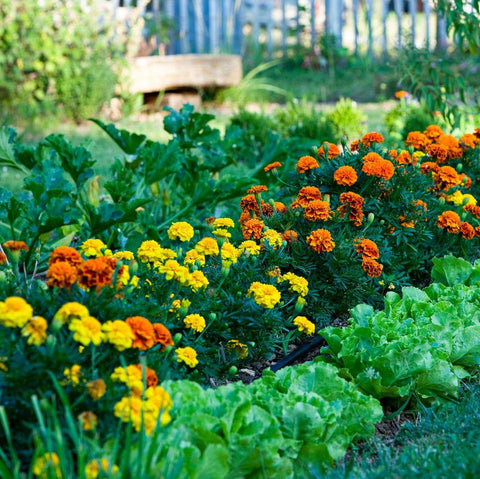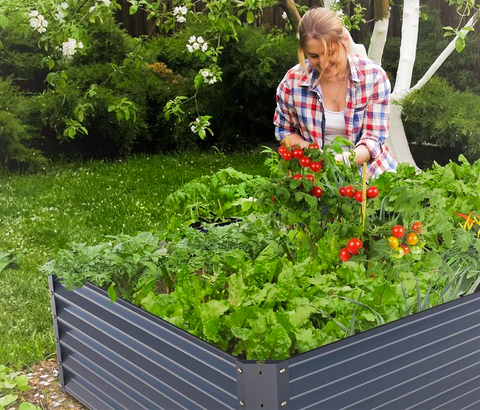As the vibrant colors of summer begin to fade and the air turns crisp, the arrival of fall heralds the perfect time for planting trees and shrubs. While spring may be the more popular planting season, the cooler temperatures and increased moisture of autumn create ideal conditions for establishing strong roots. In this comprehensive guide, we'll delve into the world of fall planting, offering valuable tips and insights to help your trees and shrubs thrive in the seasons to come.The following content also has some reference value for raised garden beds.

Timing Is Key
Before you start digging, it's crucial to choose the right time for your fall planting. Typically, the best window for fall planting is from late September to early November. Planting during this period allows your trees and shrubs to take advantage of the still-warm soil while avoiding the extreme heat of summer.
Keep an eye on your local climate and weather forecasts. You want to plant before the ground freezes but after the hottest days of summer have passed. This way, your new additions can establish their roots before the dormant winter months.
Selecting the Right Trees and Shrubs
Choosing the right trees and shrubs for your location is a fundamental step in ensuring their success. Consider the following factors when selecting your plants:
Hardiness Zone: Determine your USDA hardiness zone to identify which trees and shrubs are best suited for your climate. Different zones have specific temperature ranges, and planting within your zone increases the chances of survival.
Soil Type: Take note of your soil type, whether it's sandy, loamy, or clayey. Different species have varying soil preferences, and selecting plants that thrive in your soil type will lead to healthier growth.
Sunlight Requirements: Analyze the sunlight patterns in your planting area. Some trees and shrubs prefer full sun, while others thrive in partial or full shade. Make sure your chosen plants align with the available light.
Mature Size: Consider the mature size of the trees and shrubs. Ensure they have adequate space to grow without overcrowding or interfering with structures, utilities, or other plants.
Local Native Species: Whenever possible, choose native trees and shrubs. Native species are adapted to your area's climate and soil conditions, making them generally easier to maintain.
Proper Planting Techniques
Once you've selected the right trees and shrubs for your location, it's time to get your hands dirty. Here are the essential steps for proper planting:
Dig the Hole: Dig a hole that's roughly two to three times wider than the root ball of the tree or shrub. The depth of the hole should be just deep enough to accommodate the root ball at ground level.
Remove Packaging: If your tree or shrub is in a container, carefully remove it from the pot. If it's balled and burlapped, remove any wires or strings but leave the burlap intact. If it's in a plastic pot, gently remove the pot but avoid disturbing the roots.
Inspect Roots: Before planting, inspect the roots for any damage or circling. Gently untangle and spread out any circling roots. Trim any damaged or excessively long roots.
Backfill with Soil: Place the tree or shrub in the hole and backfill with the soil you removed. Ensure that the top of the root ball is level with the surrounding ground.
Water Thoroughly: After planting, water your tree or shrub deeply. This helps settle the soil and eliminates air pockets around the roots.
Mulch: Apply a layer of mulch around the base of the tree or shrub, leaving a gap around the trunk to prevent moisture from accumulating against the bark. Mulch helps retain soil moisture and regulate temperature.

Watering Schedule
Proper watering is essential for the establishment of strong roots. Follow these guidelines for effective watering:
Initial Watering: After planting, water your tree or shrub thoroughly to settle the soil and provide moisture to the roots. Ensure the entire root ball is moistened.
Regular Deep Watering: During the fall, continue to water your newly planted trees and shrubs regularly. Deep watering encourages root growth. Aim for about an inch of water per week, either from rainfall or manual watering.
Monitor Soil Moisture: Check the soil moisture regularly. Stick your finger into the soil about two inches deep. If it feels dry at that depth, it's time to water.
Avoid Overwatering: While consistent moisture is crucial, avoid overwatering, which can lead to root rot. Well-draining soil and proper mulching can help prevent overwatering.
Fertilization and Feeding
In most cases, newly planted trees and shrubs do not require heavy fertilization during the fall. However, it's a good practice to incorporate organic matter like compost into the soil when planting. This provides essential nutrients and improves soil structure.
Avoid using high-nitrogen fertilizers in the fall, as they can promote new growth that may not harden off before winter, making the plants more susceptible to cold damage.
Protecting from Wildlife and Pests
As fall approaches, many animals and pests are on the lookout for food, and your newly planted trees and shrubs can become targets. Here are some protective measures to consider:
Deer and Rabbit Protection: Use fencing or tree guards to protect against deer and rabbit browsing. These animals can severely damage young trees and shrubs.
Rodent Control: Implement rodent control measures to prevent mice and voles from girdling the bark of young trees during the winter months.
Mulch Barrier: Keep mulch away from the base of trees and shrubs to prevent rodents from nesting there.
Pruning and Maintenance
While fall planting doesn't require extensive pruning, it's a good idea to remove any dead or damaged branches. Proper pruning can encourage healthy growth and shape the tree or shrub.
Throughout the fall and winter, monitor your newly planted trees and shrubs for any signs of stress or disease. Promptly address any issues to ensure their well-being.
Winter Protection
In regions with harsh winters, consider providing some winter protection for your newly planted trees and shrubs. This can include:
Mulch: Add an extra layer of mulch around the base of the plants to insulate the roots and maintain soil moisture.
Anti-Desiccant Spray: Apply an anti-desiccant spray to evergreen trees and shrubs to reduce water loss through transpiration.
Burlap Wrapping: In areas with heavy snow and ice, wrap the trunks of young trees with burlap to protect them from winter damage.
Patience and Monitoring
Establishing strong roots takes time, so be patient. Your newly planted trees and shrubs may not show significant above-ground growth during the fall and winter, but that's perfectly normal. The focus is on root development.
Continuously monitor the soil moisture, especially during dry periods, to ensure your plants receive adequate hydration.

Celebrate Spring Growth
As the days grow longer and warmer, your fall-planted trees and shrubs will begin to show signs of growth in the spring. Celebrate the emergence of new leaves and blossoms, knowing that the strong roots you've nurtured through the fall and winter have laid the foundation for years of beauty and vitality.
In conclusion, fall planting offers an excellent opportunity to establish strong roots for your trees and shrubs. With proper timing, selection, planting techniques, watering, and care, your newly planted additions will thrive and enhance your landscape for years to come. So, roll up your sleeves, embrace the autumn season, and get ready to watch your living treasures flourish in the seasons ahead.









